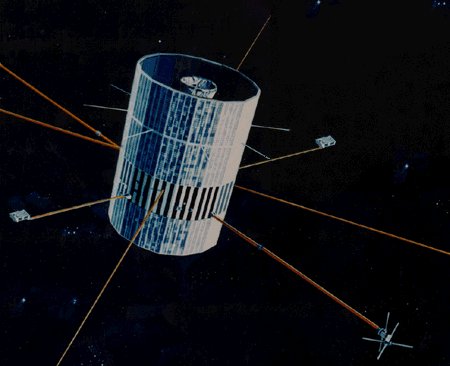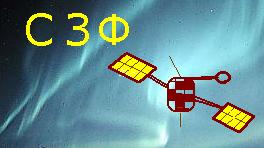|
Исскуственные спутники Земли (ИСЗ)
Космические исследования основываются на измерениях с помощью
исскуственных спутников Земли (ИСЗ) и межпланетных космических
аппаратах (КА). ИСЗ по параметрам траектории подразделяются на низковысотные
(300 - 1000 км), геосинхронные, с эллиптической орбитой, полярные
и пр.
По назначению ИСЗ делятся на научные, связные, военные, и пр.,
по начинке - на автоматические и пилотируемые.
Сотни научных спутников выпущены с начала космической эры и описать их или просто
перечислить невозможно.
Геосинхронная орбита
Круговая орбита в плоскости экватора на расстоянии 6.6 земных радиусов , на которой орбитальная скорость равна скорости вращения Земли.
В результате геосинхронный спутник неподвижен по отношению к земному наблюдателю.
Геосинхронная орбита особенно удобна для спутников связи и в
настоящее время практически полностью занята.
Эллиптическая орбита
Орбиты с большим отличием между апогеем и перигеем. Большое разнообразие орбит и периодов обращения.
Низковысотные орбиты Круговые орбиты с высотой примерно от 300 до 1000 км. Пилотируемые станции (Мир, МКС)
имеют небольшую высоту и наклонение, чтобы не попасть в радиационные пояса и авроральную зону. Полярнын спутники,
наоборот, заходят в высокие широты.
СПУТНИКИ
Некоторые сведения

IMP-8
Запущен 26 октября 1973 г. Это последний спутник серии IMP, часть программы NASA Explorer. Задача — мониторинг солнечного ветра и магнитосферы.
Апогей и перигей примерно 280 000 км и 150 000 км. В солнечном ветре 7 - 8 дней из 12.2 дней орбиты.
Масса 400кг телеметрия 1.6 кб/с. (описание на IMP-8 homepage at GSFC).
IMP-8 measures the following fields: Magnetic field up to 108 nT and electrostatic fields and waves
from 1 Hz to 200 kHz. IMP-8 has a variety of instruments for measuring the properties of the solar wind
and cosmic rays.
The satellite measures composition, distribution and energy spectra of these particle flows
(source: IMP-8 homepage at GSFC).
IMP-8 работал до 2003 г , намного превысив запланированное время.

WIND был запущен 1 Ноября 1994г., измерял параметры солнечного ветра первые два года на
a sunward, multiple double-lunar swing-by orbit с макс. апогеем f 1.5 миллионов км в точке Лагранжа 1 (L1).
It was then planned to place it on a Halo orbit around L1.
The satellite visited the L1 point in May 1997, but actually
continues to circle Earth (source: WWW-Site from ISTP at GSFC).
WIND has a minimal projected lifetime of 3 years. However, the satellite may remain operational for several years.
The satellite has a total weight of 1200 kg with 300 kg hydrazine fuel.
WIND houses 8 experiments:
- The Magnetic Fields Sensor (MFI) measures the interplanetary magnetic field vector
ranging up to 65.5 nT.
- The Radio and Plasma Waves sensor (WAVES) detects low frequency waves from DC to 10 kHz,
thermal noise from 4 to 256 kHz and radio waves from 20 kHz to 14 MHz.
- The Transient Gamma Ray Spectrometer (TGRS) observes cosmic gamma-ray bursts and gamma-ray lines in solar flares
with energies from 15 keV to 10 MeV.
- The Gamma Ray Spectrometer (KONUS) performs studies similar to the TGRS experiment.
- KONUS is the first Russian instrument to fly on an American satellite. KONUS also measures the cosmic ray background,
interrupted only to read out bursts. The combined data from TGRS and KONUS provide coverage of the full sky.
- The Solar Wind Experiment (SWE) measures density, spatial distribution, energy spectra and composition of the low
energy particles from 10 eV to 22 keV. The Energetic Particle Acceleration,
- Composition and Transport Experiment (EPACT) provides information of high-energy particles in the solar wind.
Electrons and ions from H to Fe are detected with an energy range of 0.1 to 500 .
- The 3D PLASMA experiment gives the three dimensional distribution of plasma and energetic electrons from a few eV
to several MeV, thus covering the energy gap between SWE and EPACT.
- The Solar Mass Sensor (SMS) measures the ion composition. It consists of three composition analyzers for
energies from 0.5 to 230 , measuring mass, charge and isotopic composition of the solar wind (source:
WWW-Site from ISTP at GSFC).

SOHO запущен 2 декабря 1995 года на орбиту гало вокруг точки Лагранжа L1.
Это первый европейский спутник в этой точке. Работа расчитана на 2 года. Но батарей хватит и на декаду.
Вес I1850 кг, высота 3.8 м. Непрерывная передача данных на Землю со скоростью T200 кбит/с.
The SOHO experiments form three groups:
- GOLF (Global Oscillations at Low Frequencies),
- VIRGO (Variability of Solar Irradiance and Gravity Oscillations) and MDI/SOI (Michelson Doppler
Imager/Solar Oscillations Investigation) measure the properties of the solar interior.
GOLF and VIRGO make measurements to detect solar oscillations by measuring velocity and irradiance of the full
solar disk (and with 12 resolution elements in the case of VIRGO).
- MDI/SOI measures the velocity distribution at the solar surface with a 1024 х 1024 Pixel resolution, permitting
precise information about the convective zone.
- SUMER (Solar Ultraviolet Measurements of Emitted Radiation), CDS (Coronal Diagnostic Spectrometer),
EIT (Extreme ultraviolet Imaging Telescope), UVCS (Ultraviolet Coronograph Spectrometer),
and LASCO (Large Angle and Spectrometric Coronograph) observe the solar corona.
SUMER, CDS and EIT provide high resolution images and spectra of the lower corona. UVCS and LASCO observe the
corona out to 10 and 30 solar radii, respectively, to characterize the coronal heating and the source
of the solar wind.
- SWAN (Solar Wind Anisotropies) measures the large scale hydrogen density from 20 solar radii over the
entire celestial sphere by mapping the Ly- light emitted by the solar wind hydrogen.
- CELIAS (Charge, Element, and Isotope Analysis System), COSTEP (Comprehensive Suprathermal and Energetic
Particle Analyzer) and ERNE (Energetic and Relativistic Nuclei and Electron experiment) analyze the properties
of the solar wind that streams by SOHO in-situ. CELIAS measures the velocity, ionization stage and chemical
composition of the low energy ions in the solar wind. CELIAS also carries a Solar Extreme-ultraviolet
Monitor (SEM).
- COSTEP and ERNE measure high energy ions and electrons in the solar wind. (source: SOHO homepage at NASA)
SOHO is a project of international cooperation between ESA and NASA.)
SOHO performs excellent observations of the Sun but it does not measure the solar wind magnetic field nor
electrons below 60 keV.
Четыре идентичных спутника CLUSTER для исследования магнитосферы были потеряны после неудачного старта ракеты
Ариан-4 4 июня 1996г и затем повторно запущены в России в 2000 г.

Проект INTERBALL включает два спутника, изготовленные в России и два субспутника, изготовленные
в Чехословакии.
Хвостовая пара была запущенв 3 августа 1995 на эллиптическую орбиту с апогеем 200'000 км.
Авроральная пара (спутник и субспутник) была запущена 29 августа 996 года на орбиту с апогеем 20 000 км.
The satellites measure the properties plasma particles fluxes, magnetic and electric fields, solar radio emission
and X-rays. The tail probe is in the solar wind for a fair fraction of the year but data taking is not
continuous (source: INTERBALL homepage at Space Research Institute, Russian Academy of Sciences).
Спутник POLAR был запущен 24 февраля 1996.для исследования высокоширотной полярной области.
(Орбита с апогеем и перигеем 60'000 и 13'000 км.
Спутник GEOTAIL был запущен 24 июля 1992 на расстояние до 1300 '000 км отЗемли.
Спутник ULYSSES был запущен 6 октября 1990 с орбитой над эклиптикой для исследования гелиосферы на высоких
широтах. После разгона вокруг Юпитера спутник поднялся на уровень солнечного полюса в 1994 и 1995 гг.
Орбитальный период спутника 6 лет
Два спутника PHOBOS были запущены к Марсу и были потеряны (связь)
на подлете к Марсу.
| |





